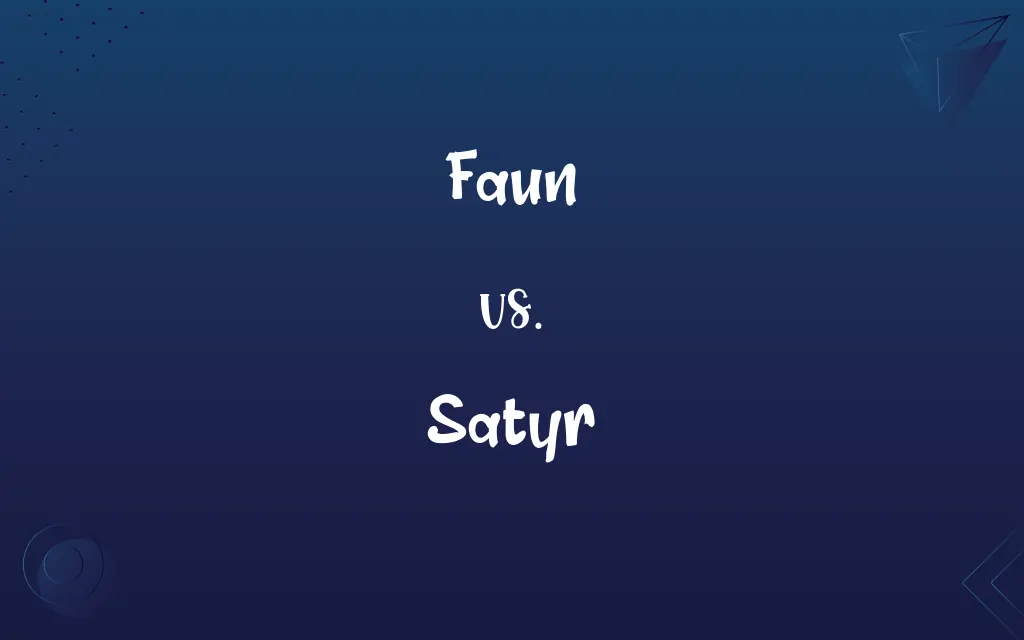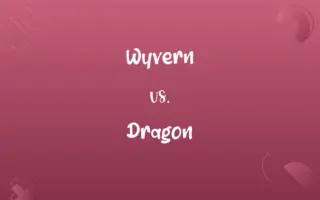Faun vs. Satyr: Know the Difference

By Shumaila Saeed || Published on February 1, 2024
Fauns, in Roman mythology, are forest spirits with the body of a man and the legs and horns of a goat; Satyrs, in Greek mythology, are similar but more wild and unruly, often associated with Dionysus.

Key Differences
Fauns, originating in Roman mythology, are depicted as having the body of a man but with the horns, tail, and sometimes the legs of a goat. They symbolize peace and fertility and are often shown as gentle beings. Satyrs, from Greek mythology, share similar physical traits but are more known for their rowdy and unrestrained behavior, often accompanying Dionysus, the god of wine and revelry.
Shumaila Saeed
Feb 01, 2024
In literature and art, Fauns are typically portrayed as shy, elusive creatures, fond of nature and music, often seen playing flutes. They embody the spirit of the woods and pastoral life. Satyrs, however, are depicted as wild and mischievous, often in pursuit of physical pleasures, indulging in music, dancing, and wine.
Shumaila Saeed
Feb 01, 2024
The demeanor of Fauns is usually gentle and whimsical, interacting with other creatures and humans in a playful yet harmless manner. In contrast, Satyrs are often shown as boisterous and indulgent, occasionally causing trouble due to their excessive fondness for wine and women.
Shumaila Saeed
Feb 01, 2024
Fauns, while sharing physical traits with Satyrs, have a distinctly Roman flair in their depiction, often integrated into Roman tales and lore. Satyrs, deeply rooted in Greek mythology, are closely tied to the worship of Dionysus and the wild aspects of nature and human behavior.
Shumaila Saeed
Feb 01, 2024
The cultural significance of Fauns is more aligned with nature and rustic tranquility, often serving as a symbol of the harmonious coexistence of humans and nature. Satyrs, on the other hand, represent the untamed, primal aspects of nature and humanity, often serving as a reminder of the wild, uncontrolled forces in both.
Shumaila Saeed
Feb 01, 2024
ADVERTISEMENT
Comparison Chart
Physical Description
Half-human, half-goat, often gentle
Half-human, half-goat, wild appearance
Shumaila Saeed
Feb 01, 2024
Behavior
Shy, playful, music-loving
Rowdy, indulgent, often in pursuit of pleasure
Shumaila Saeed
Feb 01, 2024
Cultural Role
Symbolize harmony with nature
Represent untamed nature and behavior
Shumaila Saeed
Feb 01, 2024
ADVERTISEMENT
Faun and Satyr Definitions
Faun
A mythological creature, half-human, half-goat, associated with Roman mythology.
In the forest clearing, a faun played a sweet melody on his flute.
Shumaila Saeed
Jan 15, 2024
Satyr
A symbol of indulgence and physical pleasure, often depicted in Greek art.
In the ancient fresco, a satyr was shown playing a lyre at a Dionysian feast.
Shumaila Saeed
Jan 15, 2024
Faun
A gentle, nature-loving being from Roman lore, known for its musical ability.
The faun's music could be heard echoing through the forest, enchanting all who heard it.
Shumaila Saeed
Jan 15, 2024
Satyr
A mythical being with a penchant for mischief and revelry, rooted in Greek culture.
At the festival, actors dressed as satyrs performed scenes of merriment and chaos.
Shumaila Saeed
Jan 15, 2024
Faun
A creature of the woods, embodying the spirit of nature and rustic life.
Among the trees, the faun danced, one with the natural world around him.
Shumaila Saeed
Jan 15, 2024
ADVERTISEMENT
Satyr
A companion of Dionysus, embodying excess and the untamed aspects of nature.
The satyr, with a wineskin in hand, led the procession in honor of Dionysus.
Shumaila Saeed
Jan 15, 2024
Faun
A symbol of peace and pastoral life, often depicted in art and literature.
The sculpture of the faun in the garden brought a sense of tranquility.
Shumaila Saeed
Jan 15, 2024
Satyr
A creature representing primal instincts, frequently seen in Greek mythology.
The satyr, mischievous and unrestrained, was a common character in Greek legends.
Shumaila Saeed
Jan 15, 2024
Faun
A mythical being often shown as playful and elusive, part of Roman tales.
The children whispered stories of a friendly faun who lived in the ancient woods.
Shumaila Saeed
Jan 15, 2024
Satyr
A Greek mythological creature, half-man, half-goat, known for wild behavior.
The satyr reveled in the forest, celebrating with other followers of Dionysus.
Shumaila Saeed
Jan 15, 2024
Faun
Any of numerous rural deities represented as having the body of a man and the horns, ears, tail, and sometimes legs of a goat.
Shumaila Saeed
Jan 14, 2024
Satyr
Often Satyr Greek Mythology A woodland creature depicted as having the pointed ears, legs, and short horns of a goat and a fondness for unrestrained revelry.
Shumaila Saeed
Jan 14, 2024
Faun
(Roman mythology) A woodland creature with pointed ears, legs, and short horns of a goat and a fondness for unrestrained revelry.
Shumaila Saeed
Jan 14, 2024
Faun
(entomology) Any of various nymphalid butterflies of the genus Faunis.
Shumaila Saeed
Jan 14, 2024
Faun
A god of fields and shipherds, diddering little from the satyr. The fauns are usually represented as half goat and half man.
Satyr or Faun, or Sylvan.
Shumaila Saeed
Jan 14, 2024
Satyr
Any of various satyrid butterflies having brownish wings marked with eyespots.
Shumaila Saeed
Jan 14, 2024
Faun
Ancient Italian deity in human shape, with horns, pointed ears and a goat's tail; equivalent to Greek satyr
Shumaila Saeed
Jan 14, 2024
Satyr
(Greek mythology) A sylvan deity or demigod, male companion of Pan or Dionysus, represented as part man and part goat, and characterized by riotous merriment and lasciviousness, sometimes pictured with a perpetual erection.
Shumaila Saeed
Jan 14, 2024
Satyr
Any of various butterflies of the nymphalid subfamily Satyrinae, having brown wings marked with eyelike spots; a meadow brown.
Shumaila Saeed
Jan 14, 2024
Satyr
A sylvan deity or demigod, represented as part man and part goat, and characterized by riotous merriment and lasciviousness.
Rough Satyrs danced; and Fauns, with cloven heel,From the glad sound would not be absent long.
Shumaila Saeed
Jan 14, 2024
Satyr
Any one of many species of butterflies belonging to the family Nymphalidæ. Their colors are commonly brown and gray, often with ocelli on the wings. Called also meadow browns.
Shumaila Saeed
Jan 14, 2024
Satyr
One of a class of woodland deities; attendant on Bacchus; identified with Roman fauns
Shumaila Saeed
Jan 14, 2024
Repeatedly Asked Queries
Are Fauns considered peaceful creatures?
Yes, Fauns are often depicted as peaceful, gentle beings.
Shumaila Saeed
Feb 01, 2024
What defines a Satyr?
A Satyr is a Greek mythological being, half-man, half-goat, known for wild behavior.
Shumaila Saeed
Feb 01, 2024
What is a Faun?
A Faun is a Roman mythological creature, part human, part goat, associated with nature.
Shumaila Saeed
Feb 01, 2024
Can Fauns be found in Greek mythology?
While similar to Greek Satyrs, Fauns are specifically part of Roman mythology.
Shumaila Saeed
Feb 01, 2024
Do Satyrs always represent indulgence?
Generally, yes. Satyrs symbolize excess, indulgence, and primal instincts.
Shumaila Saeed
Feb 01, 2024
What is the typical behavior of a Faun?
Fauns are typically portrayed as shy, whimsical, and fond of music.
Shumaila Saeed
Feb 01, 2024
Are Satyrs always male in Greek mythology?
Yes, in traditional Greek mythology, Satyrs are always depicted as male.
Shumaila Saeed
Feb 01, 2024
Do Fauns play a musical instrument in myths?
Yes, Fauns are frequently associated with playing flutes or other musical instruments.
Shumaila Saeed
Feb 01, 2024
What is the association of Satyrs with Dionysus?
Satyrs are considered companions of Dionysus, the Greek god of wine and festivity.
Shumaila Saeed
Feb 01, 2024
What role do Fauns play in Roman stories?
In Roman mythology, Fauns are seen as spirits of the forest and natural world, often involved in tales symbolizing peace and harmony with nature.
Shumaila Saeed
Feb 01, 2024
How do Fauns and Satyrs differ in physical appearance?
Fauns and Satyrs are both half-human, half-goat, but Fauns are often depicted as gentler, while Satyrs have a wilder, more unrestrained appearance.
Shumaila Saeed
Feb 01, 2024
What kind of festivals or celebrations involved Satyrs in ancient Greece?
Satyrs were prominently featured in Dionysian festivities, which celebrated wine, fertility, and the arts, often characterized by wild dancing and revelry.
Shumaila Saeed
Feb 01, 2024
How are Satyrs usually depicted in mythology?
Satyrs are often shown as rowdy, indulgent, and pursuing physical pleasures.
Shumaila Saeed
Feb 01, 2024
Can Fauns be seen in modern literature or media?
Yes, Fauns appear in various forms in modern literature, films, and other media, often depicted as mystical forest beings.
Shumaila Saeed
Feb 01, 2024
Do Fauns and Satyrs have any religious significance?
In their respective cultures, Fauns and Satyrs had religious undertones. Fauns were associated with rustic deities, while Satyrs were closely linked to Dionysus, the god of wine and festivity.
Shumaila Saeed
Feb 01, 2024
How are Satyrs typically involved in Greek theater?
In Greek theater, Satyrs were often portrayed in Satyr plays, a form of tragicomedy featuring these mythological creatures in various escapades, usually with humorous and ribald themes.
Shumaila Saeed
Feb 01, 2024
Do Fauns have any magical abilities?
While not typically described as having magical powers, Fauns are often portrayed with a mystical connection to nature and music.
Shumaila Saeed
Feb 01, 2024
Is there a female counterpart to the Faun in Roman mythology?
The female counterpart to the Faun in Roman mythology is less prominent, but similar beings are sometimes referenced, akin to nymphs or forest spirits.
Shumaila Saeed
Feb 01, 2024
Were Satyrs always considered benevolent in Greek tales?
No, Satyrs in Greek mythology were often portrayed as mischievous or even troublesome due to their unrestrained nature.
Shumaila Saeed
Feb 01, 2024
Share this page
Link for your blog / website
HTML
Link to share via messenger
About Author
Written by
Shumaila SaeedShumaila Saeed, an expert content creator with 6 years of experience, specializes in distilling complex topics into easily digestible comparisons, shining a light on the nuances that both inform and educate readers with clarity and accuracy.









































































